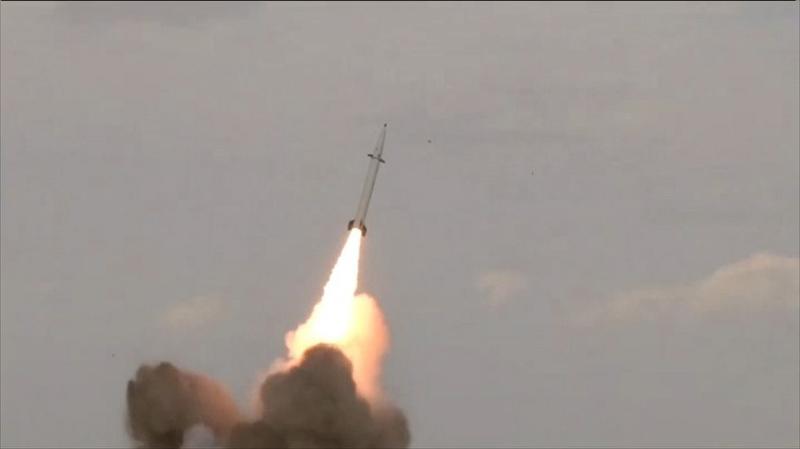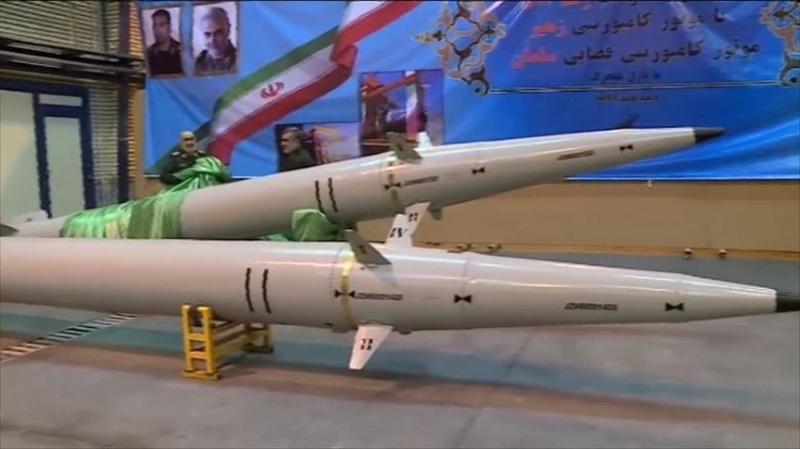 This image grab from footage obtained from the state-run Iran Press news agency on Feb 9, 2020 shows the launch of the new Raad-500 missile, a short-range ballistic missile by Iran's Islamic Revolutionary Guard Corps (IRGC) that they say can be powered by a "new generation" of engines designed to put satellites into orbit. (IRAN PRESS / AFP)
This image grab from footage obtained from the state-run Iran Press news agency on Feb 9, 2020 shows the launch of the new Raad-500 missile, a short-range ballistic missile by Iran's Islamic Revolutionary Guard Corps (IRGC) that they say can be powered by a "new generation" of engines designed to put satellites into orbit. (IRAN PRESS / AFP)
TEHRAN/DUBAI - Iran unveiled a new short-range missile called Thunder on Sunday and launched a satellite named Zafar (Victory) which failed to reach orbit.
The homemade satellite carrier Simorgh launched the satellite into space, but the satellite could not gain the desired velocity to reach the required orbit, spokesman for space projects of Iran's Defense Ministry Ahmad Hosseini said.
The satellite carrier put Zafar at an altitude of 540 km, but the process could not be completed, Hosseini was quoted by state IRINN TV as saying.
Iran's homemade satellite carrier Simorgh put the satellite Zafar at an altitude of 540 km, but the process could not be completed, a spokesman for space projects of Iran's Defense Ministry was quoted by state IRINN TV as saying
“I wanted to make you happy with good news but sometimes life does not go the way we want it to. The launch was not successful,” tweeted Iranian Minister of Information and Communications Technology Mohammad Javad Azari-Jahromi.
READ MORE: Iran to launch satellite; US says program linked to missiles
Hosseini noted that Iranian space experts will analyze and work on the data, correct the problems and prepare to relaunch the satellite.
Iran launched the satellite at Imam Khomeini Space Center in Semnan province, some 230 km southeast of Iran's capital Tehran.
The launch came concurrent with the celebrations for the 41st anniversary of Iran's 1979 Islamic Revolution.
The 90-km Zafar was a remote-sensing satellite equipped with color cameras and designed for surveying oil reserves, mines, jungles and natural disasters.
Washington has criticized Tehran's space ambitions, claiming that it helps Tehran advance its ballistic missile program. Tehran, however, has denied the allegations, saying that its space program aims at civilian and peaceful ends.
 This image grab from footage obtained from the state-run Iran Press news agency on Feb 9, 2020 shows the unveiling Raad-500 missile, a short-range ballistic missile by Iran's Islamic Revolutionary Guard Corps. (IRAN PRESS / AFP)
This image grab from footage obtained from the state-run Iran Press news agency on Feb 9, 2020 shows the unveiling Raad-500 missile, a short-range ballistic missile by Iran's Islamic Revolutionary Guard Corps. (IRAN PRESS / AFP)
State television said Iran’s elite Revolutionary Guards Corps, which is in charge of the country’s missile program, had unveiled the new missile, called Raad-500, Farsi for Thunder.
Iran’s clerical rulers have said Tehran’s missile program is solely defensive.
ALSO READ: Iran accuses France, Germany and UK of false missile claims
The first picture the satellite had been due to transmit to state media would have been of the slain Iranian military commander Qassem Soleimani, Azari-Jahromi told state TV.
The IRGC launched the new Raad-500 missile from Iran’s Imam Khomeini Space Center in Iran’s Semnan province
He said it was launched from Iran’s Imam Khomeini Space Center in Iran’s Semnan province, a facility under the control of the country’s defense ministry.
State television said the Raad-500 missile was half the weight of a similar missile, the Fateh-110, but its range was about 200 km more and it could be powered by a new generation of engines designed to put satellites into orbit.
There was no immediate US comment on the announcements.
Israeli Prime Minister Benjamin Netanyahu noted the satellite launch had failed and said Israel was continuing to curb Iranian military reach.
ALSO READ: Israel: Iran, Hezbollah intensifying missile efforts
In August 2019, an Iranian rocket exploded on its launch pad at Imam Khomeini Space Center before its scheduled launch.
Iran sent its first bio-capsule containing living creatures into space in February 2010, using a Kavoshgar-3 carrier.
Iran's first home-built satellite Omid was launched in 2009.


